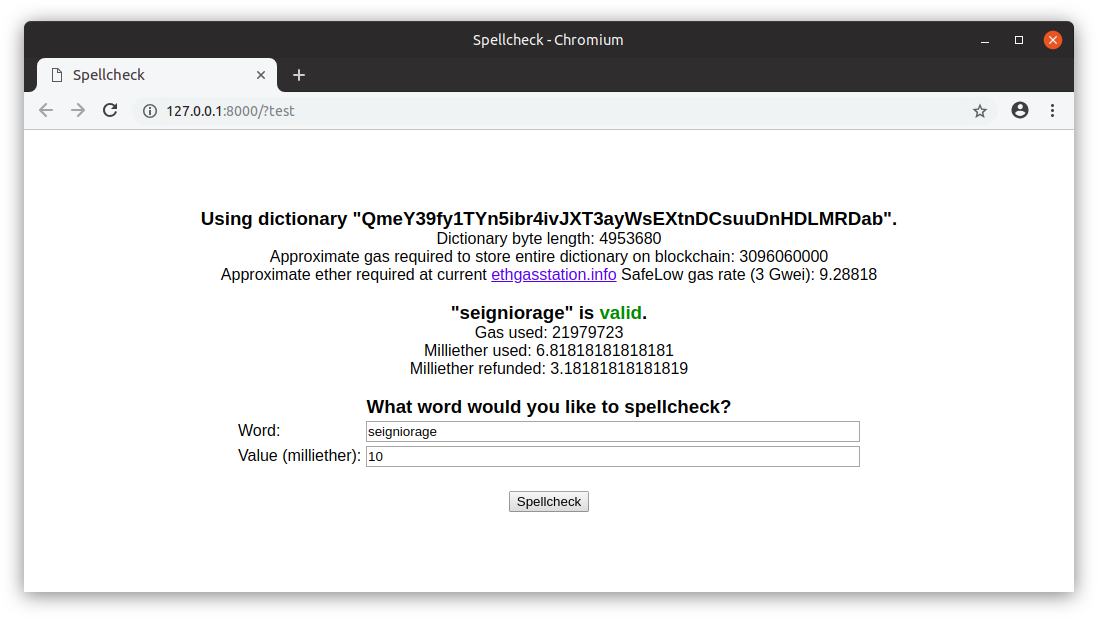Samuel E. Moelius III (sam@moeli.us)
If EIB could be of use to your project, then please contact me (sam@moeli.us) and/or consider a donation to 0xD07C0Bb4B0E5943cbeD93c337686217D91655a2e.
Contents
Ethereum Input Bus (EIB) provides a means for moving data onto the Ethereum blockchain securely.
More specifically, EIB allows an Ethereum contract to crowd-source a read from the InterPlanetary File System (IPFS), and for a respondent to supply the data and prove that the data is correct, i.e., the data comes from the correct file, the data comes from the correct offset within that file, and the data is of the correct length.
The EIB repository consists of:
-
the EIB contract itself (receives requests, verifies responses, etc.),
-
a prototype EIB supplier (
eibs) implemented in TypeScript, -
example webapps written to use EIB, and
-
utilities for working with EIB.
At the top of the EIB repository, type the following.
make
cd examples/spellcheck
make demo
What is going on? The command make demo does essentially the following.
-
launch a test Ethereum blockchain (
ganache-cli) -
deploy several contracts to the blockchain, including one called
Spellcheck -
launch a webapp to interact with the
Spellcheckcontract -
launch an instance of
eibsto supply data to the contract -
open the webapp in a browser
The Spellcheck contract does what its name suggests: it checks the validity of a word against a
dictionary. However, the dictionary is not stored on the blockchain: at 4.8 megabytes, storing that
much data on the blockchain would be rather expensive. Instead, the dictionary is stored off-chain;
when the Spellcheck contract needs data from the dictionary, the data is obtained using EIB.
-
(1) A contract requests data from
eibby callingrequest. -
(2)
eibemits aRequest_announcedevent. -
(3) A supplier (e.g.,
eibs) notices the event and obtains the relevant file from IPFS. -
(4) The supplier extracts the requested data and sends it to
eibby callingsupply. -
(5)
eibverifies the data (see below) and notifies the requesting contract via a callback.
The call to request includes the root of a Merkle tree
whose leaves hold the contents of the IPFS file. Along with the data, the supplier must send the
combined paths from the relevant leaves of this tree to its root. In this way, the supplier proves
that the data is correct. Put another way, this requirement ensures that eib is not fooled by a
cheating supplier who sends bogus data.
The call to request also includes the amount of Ether that the requestor is willing to pay for the
read. The supplier uses some fraction of this Ether to pay for the gas needed to verify the Merkle
proof and for the requestor's callback. The supplier keeps the remaining fraction as profit. eib
does not keep any fraction of this Ether for itself.
A requestor can cancel its request at any time before the data has been supplied.
One should be able to build EIB by simply typing make.
Alternatively, one can type make full. In addition to building EIB, make full runs all post-build
checks and all tests. Warning: On my laptop, make full currently takes about 12 minutes.
EIB can be tested in two ways:
-
with the testing framework itself responding to requests (useful for testing the EIB contract itself) or
-
with
eibsresponding to requests (useful for testingeibs).
Details are given in the EIB contract's README and in eibs'
README, respectively.
Please send bug reports to Samuel E. Moelius III (sam@moeli.us).

